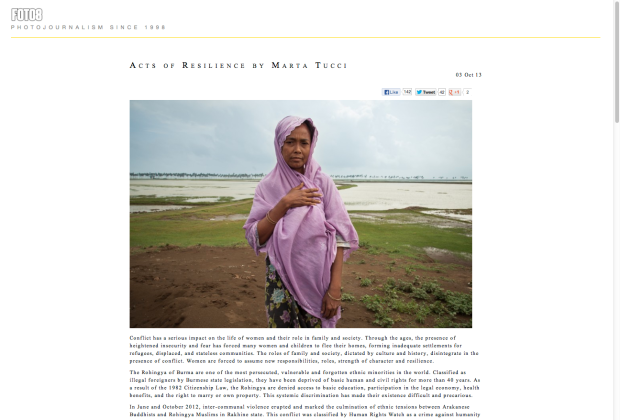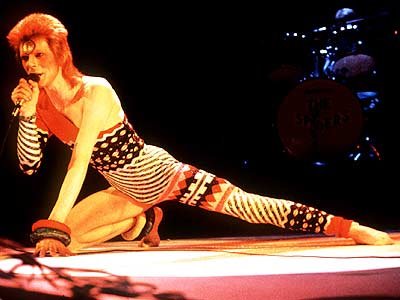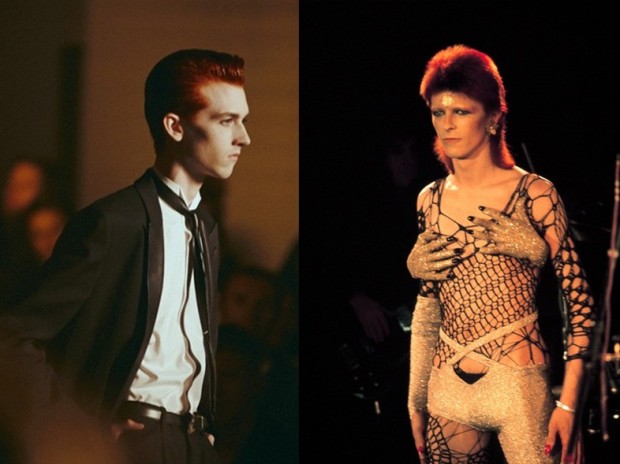In class we were shown two very different photo films featured on FOTO8. We were asked to analyse, compare and share are thoughts on each of the films.
‘Acts of Resilience’ by Marta Tucci

Acts of Resilience by Marta Tucci documents the predicament of Rohingya women highlighting their resilience, strength and individuality in the face of poverty and an impossible fate. The Rohingya of Burma is one of the most persecuted ethnic minorities in the world whom are classified as illegal foreigners by Burmese state legislation. As a result the Rohingya have been deprived of all basic human and civil rights for over 40 years.
The Rohingya are denied education, health benefits and the right to marry or own property, thus being condemned to a horrific and hopeless existence. Many flee their homes in fear of out breaking violence leaving them to live in exile in neighbouring states or Internally Displaced Person (IDP) camps, which causes even more problems for the Rohingya people. The IDP camps forbid access to healthcare, markets, humanitarian aid and other necessities for general human survival. The arrival of monsoon season brings the risk of flooding and a sickness epidemic, which could spiral out into a full-scale humanitarian disaster. The IDP camps are meant to be temporary solutions for the displaced Rohingya to live but are more and more often becoming their permanent residence.
The photo essay focuses on the women of Rohingya. The conflict has changed these women in fundamentally different ways compared to its men. Due to breaks in the social structures of Rohingya many families were left without a male figure and so women had to take on the role of the men to ensure the survival of their families and community. Symbolically the women were seen as the bearers of life, culture and ethnic identity, constantly undervalued in a male dominated community. But now they have challenged these ideas and forced to find their strength and value with their community. The projects aims to raise awareness to both the Rohingya women’s inhumane living conditions as well as their changing gender roles, strength and resilience.
I thought this was an impressive and heart wrenching story, which tempted me to view the film by Tucci. However, in class we were shown the video first. As a result, by learning the full context of the film after viewing the video, I thought it could have been better. The written context and story told within it, is so much more emotive and hard hitting then the photo film. Yet I don’t think the images are to blame. I feel it was maybe the videos execution, which could have conveyed a lot more.
I read the description of the video once more. I then watched the film once more. As a result my experience and reading of the video was entirely different. The context reiterates the artists aim to portray the women’s strength and resilience as opposed to their suffering. And I feel it does. The images are simple and concise which is poignant. Each image shows a different character in their plight. Yet all appear strong amidst disaster, never showing any sign of threat or despair. The images are not explicit or graphic, nor do they need to be. Instead they’re somewhat gentle aided by their simplicity and this is the films saving grace.
The deadpan, unembellished style of the images, gives the impression that Tucci has just used the camera as a tool to tell the story of the Rohingya people instead of creating beautiful or distressing images. The images simply evidence the characters and situation, uninterested in demonstrating artistic flare of the photographer. The deadpan, central subjects and serious expressions are reminiscent to the trusted images of Richard Avedon and its these aesthetics which evoke believability in the viewer. All the women are central and everything radiates from them, so you believe that they are in control and powerful in each image. This is what they wanted to convey.
The film has a soundscape, consisting of a women telling her story which appears as a translated transcript below the video and a piece of emotive music. I feel this does add something to the experience of the video but distracted me from really delving in deeper with each character and each image. I would have liked to have heard the stories of each characters instead of just one random female.
Overall, the film showed me the importance of offering the viewer more insight and context into a project, and how the order of viewing said information can affect the way you view it. It also showed me how images don’t have to evidence the horrors of poverty or starvation for a viewer to understand that that is the reality. Creating softer, less explicit images can actually create a higher sense of believability and trust with the photographer, as we see they haven’t exploited or took it too far.
‘Gezi is Everywhere’ by Colin Boyd Shafer

With this photo film I read the context first then viewed the video, which again gave me a better understanding and appreciation for the images. Gezi is Everywhere by Colin Boyd Shafer embodies a similar style to Acts of Resilience, the images are gentler and less explicit, only Shafer has taken it a step further. We witness the event through his artistic eye and point of view entirely, thus making us view the event unravelling in Gezi completely differently if we were to see it in a news report for example. Shafer focuses on the magical, more joyful parts of his time spent in Gezi as opposed to the authorities tearing the community apart.
The series of images were taken in Istanbul at the beginning of what is an on going movement against the current leadership of Turkey. The text, which introduces the photo film, is from that of the photographer as he describes the event from his perspective. For Shafer, it was his first experiences of the protestors in Gezi Park and Taksim Square that he remembers most vividly. The sounds of intense conversation, laughing, singing and music engulfed him into a euphoric state. There was this great sense of community, hope and happiness, ‘definitely the largest street party I have been too-where public space was truly public’. The people had set up a community garden, a place to eat and a medical area. People from all walks of lives were joined together harmoniously. He found it peculiar yet magical that all these sorts of people could be brought together so serenely. Even celebrities were visiting to show their support. It was melodious union amongst the Gezi people and its delightful atmosphere, which really moved Shafer. As a result this is what he documented and focused on when photographing the event.
He walked around the camp talking to people and taking their portraits as they were: singing, smoking, reading and so on. ‘It was peaceful’ and I feel he’s done brilliantly at encapsulating that sense of harmony and celebration in his images. We witness a couple smiling and gazing at one another, a man enjoying a drag on his cigarette and a woman resting in a tent. There’s no sign of horror or disturbance. Without the text one could even conjure up the idea that these are images from a music festival. Everything is quiet and gentle. The use of black and white images and the focus on the people’s eyes, evoke believability, beauty and make the event seem more filmic, as opposed to a news report. The images are more stylistic and less rigid compared to ‘Acts of Resilience’ but I quite like that. It reflects the photographers’ response to the event well. He didn’t want to focus on the negative rather the positive and sense of community he witnessed, something beautiful which is reinforced through beautiful images. They definitely demonstrate an artistic flare. The photo film also doesn’t have sound, leaving no other influence, just silence. I feel the experience of viewing the film would have been enhanced by sounds of the peoples’ celebrations as that was something Shafer particularly remembered. Or on the flip side combined the images with sounds of terror to create an interesting juxtaposition.
Images from the last days Shafer spent in Istanbul are also featured, but sparsely. The photo film is definitely dominated by the protestors happiness and celebrations. However, by incorporating just a few images of the horrors of the event, it makes them more jarring. It also reflects how Shafer was affected more by the happiness he witnessed as opposed to the scariness of the event. In the last few days the authorities tore the camp, its people and their dream apart through physical force, tear gas and violence. “It will never be the same – and the revolution those people were imagining didn’t materialize. Tayyip Erdogan didn’t step down. The police tore down their tents, garden, medical center, and food distribution operation… and beat them up”.
The series is subversive in the way that Shafer documented a horrific event by focusing on the positives as opposed to the negatives. It’s quite powerful and peculiar. It reminded me of conversations we have had in pervious lectures. Such as if we want to change the world we have to describe it differently. So many people have photographed the horrors of war and plights such as this protest in Istanbul, so much so that the same images are regurgitated over and over, thus desensitizing us as the audience. However, by focusing on the lighter more joyous things it’s makes us think, ‘This is what the world could be like if these things weren’t happening, let’s make it this way’. It’s really interesting. Therefore, I thought this photo film was far more effective then Acts of Resilience just because Shafer had pushed the boundaries so far and broke away from the conforms of what we would usually see at one of these events. The images are still obviously created by an artist but this reinforces the beauty of peace and simplicity he witnessed at the camp before it was destroyed.
Subversion: something that moves against the system in a subtle, quiet, underground way, thus evoking change. Engaging-inject an element of subversion in your own work so it matters.
sub·ver·sive [suhb-vur-siv] Show IPA
adjective
1.
Also, sub·ver·sion·ar·y [suhb-vur-zhuh-ner-ee, -shuh-] Show IPA . tending to subvert or advocating subversion, especially in an attempt to overthrow or cause the destruction of an established or legally constituted government.
Subversive Examples:
David Bowie as Ziggy Stardust
Pushed conformities of our perspectives of the male body within society, sexuality and the gender divide.
Benetton Adverts
“What does UNHATE mean? UN-hate. Stop hating, if you were hating. Unhate is a message that invites us to consider that hate and love are not as far away from each other as we think. Actually, the two opposing sentiments are often in a delicate and unstable balance. Our campaign promotes a shift in the balance: don’t hate, Unhate.”

Two innocent children embrace each other-one white, one black. However, there is an inbalance. The white child resembles that of an angel, with fair curling hair, rosy cheeks and booming smile. In contrast, the black child resembles that of a demon or devil, with spiked horns and blank expression. The image separates good and evil into skin colour, which is disturbing, or is that just how society makes us view it? After all it’s just two children embracing.


























